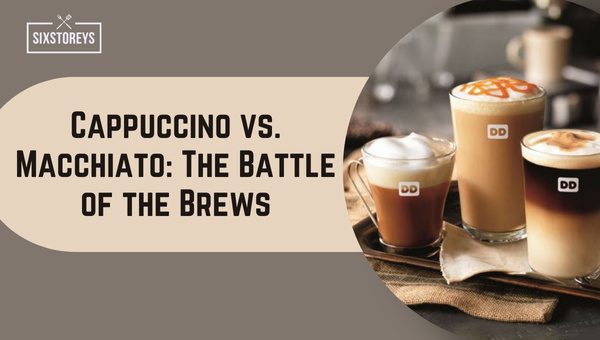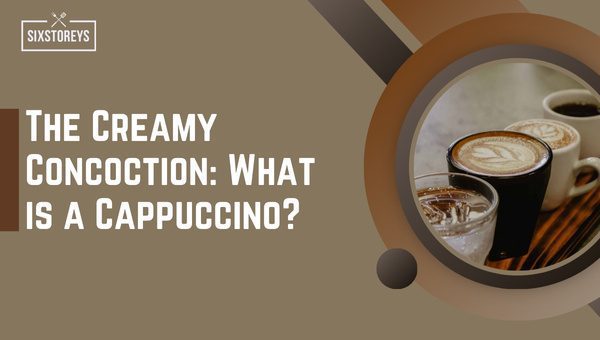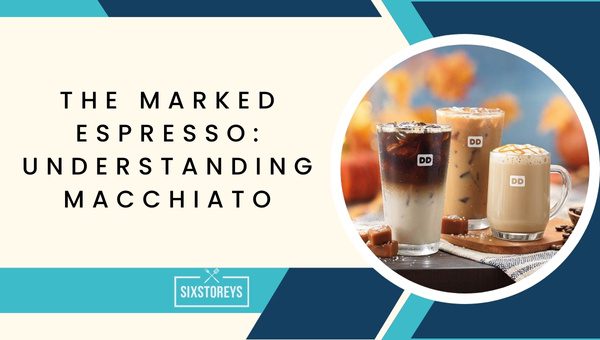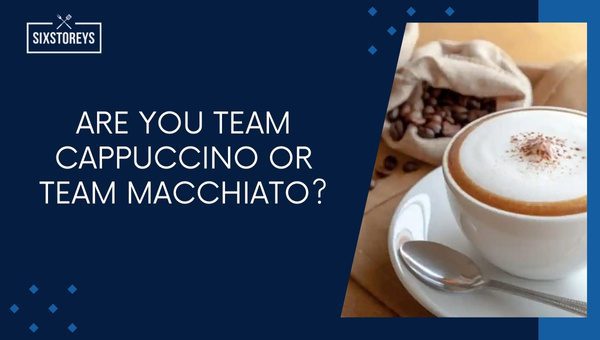Cappuccino vs. Macchiato: Who Wins the Cup?
Stepping into a coffee shop can often feel like crossing into another world brimming with exotic names and brews that can leave you perplexed. Leading the pack of the most ordered yet misunderstood beverages are the well-renowned "cappuccino" and the subtly elegant "macchiato." Whether it's the artwork that crowns a cappuccino or the distinctive "stain" that gives macchiato its name, both drinks have swooped coffee lovers worldwide off their feet. But when it comes down to "cappuccino vs macchiato," do we truly understand what these two titans of coffee culture signify? Do we grasp what sets apart the creamy concoction of a cappuccino from the marked boldness of a macchiato? Well, grab your favorite mug, and let's unravel this brew-tiful mystery together.
Also Read: Best Cold Brew Coffees to Drink
Article Includes
Cappuccino vs. Macchiato: The Battle of the Brews

From Milan to Los Angeles, intricate coffee-brewing methods have become as much a science as an art. But when it comes to the classic battle between the cappuccino and the macchiato, knowing the key differences can transform your coffee experience.
To kick things off, we’ll break down these beverages from their roots to their frothy tops.
Cappuccino
In the realm of coffee, the cappuccino is touted as a movie star, with an Italian origin story and a luxurious texture. It’s traditionally a harmonious trifecta of espresso, steamed milk, and voluminous foam, served hot and often with a sprinkle of cocoa or cinnamon to top it all off. The name ‘cappuccino’, interestingly enough, comes from the resemblance of its color to the robes of Capuchin monks.
Macchiato
The essence of the macchiato, another Italian native, is its name, translating into English as 'stained' or 'spotted.' This minor 'stain,' however, is a bold shot of espresso, either 'colored' with a tiny splash of milk (espresso macchiato) or an espresso 'staining' the milk foam (latte macchiato).
Let’s compare these beverages side by side in a table to better visualize their differences:
| Cappuccino | Macchiato | |
|---|---|---|
| Origins | Italy | Italy |
| Basis | Equal parts: Espresso, Steamed milk, Foam | Predominantly Espresso, Splash of milk or foam |
| Serving Temperature | Hot | Variable (Hot to Cold) |
| Typical Size | 6 oz | 1.5 oz (Espresso Macchiato), 12 oz (Latte Macchiato) |
| Calories (On Average) | 120-150 | 10-15 (Espresso Macchiato), 130-170 (Latte Macchiato) |
Now that you have the basic facts readily available, this will aid your understanding further as we uncover more about each unique brew. Coffee catfight? Maybe. Exciting? Absolutely!
The Creamy Concoction: What is a Cappuccino?

Belonging to the heart of traditional Italian coffee, Cappuccino is an artful blend of bold espresso, hot milk, and topped off with a thick layer of froth. The name, interestingly, finds its roots in the color of the robes worn by the Capuchin monks, mirroring the warm and inviting hue of this beverage.
The drink comprises equal thirds of espresso, steamed milk, and foamed milk. Just like life, a perfectly made cappuccino is all about balance! The espresso runs deep, offering a robustness that resonates with coffee purists. The steamed milk smoothens out the experience, and the froth—oh, the froth!—can best be described as the creamy equivalent of biting into a cloud.
Let's break down the process:
- A shot of espresso forms the base.
- Steamed milk is added to equal parts.
- Hand-frothed or machine-frothed, the top layer of foam crowns the beverage.
Now, onto exploring its equally enchanting counterpart.
The Marked Espresso: Understanding Macchiato

Macchiato, in its authentic Italian glory, differs significantly from the North American version many of us are familiar with. A traditional Italian Macchiato is a bold shot of espresso "marked" (what 'macchiato' translates to) with a dollop of frothed milk.
Here's how it usually comes together:
- Pour a single or double shot of espresso into an espresso cup.
- Add a small amount (a mark) of frothed milk on top.
In stark contrast, the North American version of macchiato, or the Caramel Macchiato famously served at Starbucks, is a milk-dominant drink with a bit of espresso, flavored syrup, lots of caramel drizzle, and a topping of froth. Here's the recipe:
- Steam the milk and add vanilla syrup.
- Pour the milk into a cup, leaving room for the espresso.
- 'Mark' the milk with a shot of espresso.
- Finish with a dusting of froth and copious amounts of caramel drizzle.
While a cappuccino feels like a cozy caffeinated embrace, the Italian Macchiato offers a robust kick. The North American Macchiato, on the other hand, is a different beast altogether. It's essentially a sweet, dessert-like treat. Both versions of Macchiato boast of a unique charm, and their allure lies in these differences, not just in taste but also in preparation and presentational aesthetics.
Cappuccino vs. Macchiato: The Perfect Foam Matters
The unique identities of cappuccino and macchiato are intimately tied to the magic of steam and milk, creating the illustrious foam that graces the top of these beverages. But what makes the perfect foam?
For our beloved cappuccino, the foam matters immensely. Typically, a cappuccino consists of equal parts espresso, steamed milk, and frothed milk. The barista skillfully steams the milk until it forms a rich, velvety foam - a process that demands a high degree of precision and practice. The result? A deliciously light and air-infused cappuccino that warms you from the first sip to the last, with its distinct texture lending an indulgent creaminess to the drink.
On the other hand, a macchiato's story is a tad different. The name itself, meaning ‘marked’ or ‘stained’ in Italian, implies the technique involved. A shot of espresso is simply "stained" with a spot of frothed milk. But don't be fooled by the minimalist approach; this spot of foam is vital to mellow out the robustness of the espresso.
A Taste Test: Comparing the Flavor Profiles

When it comes to flavor, the "cappuccino vs macchiato" battle becomes more marked.
With its well-balanced structure of espresso, steamed milk, and frothed milk, the cappuccino offers a harmonious blend of bold and smooth. The espresso provides a hearty flavor backbone, perfectly complemented by the subtle sweetness of the steamed milk. Finally, the frothy cap adds a delicate touch while maintaining the integrity of the taste - ensuring each sip is a luxurious affair.
The macchiato, conversely, presents a more straightforward, bold flavor profile. Thanks to the minimalistic use of frothed milk, the espresso’s rich and robust flavor gets a chance to shine. It's less milky and consequently, less sweet, but the frothed milk's hint serves to take the edge off, resulting in a flavorful punch that's not too overpowering.
In essence, while the cappuccino is like a warm, harmonious symphony, the macchiato is the striking solo performance. And neither is inherently better - it boils down to your personal flavor palette.
Nutritional Aspects: Which has More to Offer?
When it comes to nutritional value, both cappuccino and macchiato have their unique offerings depending on the kind of milk used, additional sugar, or other flavorings.
A standard cappuccino is typically served using 2 ounces of espresso, 2 ounces of steamed milk, and 2 ounces of foamy milk. It clocks in at approximately 120 calories, with 6 grams of fat, a negligible amount of sugar unless added, and roughly 80 milligrams of caffeine.
On the other hand, a traditional macchiato is primarily espresso with a small 'spot' or 'stain' of foamed milk, usually ranging from a few drops to an ounce. Given the lack of milk, it usually contains fewer calories, estimated to be around 60 to 70 calories, almost no fat or sugar, but the caffeine amount is higher, averaging 100 milligrams.
So, if you're watching your calorie and fat intake, a macchiato might be the way to go. But, if you're looking for a fuller, creamy feeling with less caffeine, a cappuccino will tick your boxes.
Are You Team Cappuccino or Team Macchiato?

Now that we've compared their origins, taste profiles, and nutritional aspects, we have come to the most exciting section: deciding your allegiance.
If you're a fan of rich, creamy, and velvety coffee with a perfect balance of espresso, steamed milk, and froth, then you undoubtedly belong to Team Cappuccino. This beverage promises a delightful experience with each sip, making it a perfect accompaniment for your breakfast or a cozy evening.
As for the espresso lovers who crave a more robust and direct coffee hit with only a touch of dairy to cut the bitterness – look no further. Team Macchiato is your calling. This coffee ensures you taste the essence of the espresso bean with just the slightest kiss of milk.
In this lighthearted competition of "cappuccino vs macchiato," it's essential to remember that there's no wrong choice. Whether you're Team Cappuccino or Team Macchiato, it's all a matter of personal preference. After all, the most important thing is enjoying your cup of coffee, your way!
Also Read: Best McDonald’s Coffee
How To Enjoy Your Cappuccino and Macchiato?
When it comes to fully appreciating your cup of cappuccino or macchiato, the ways are as nuanced and varied as the drinks themselves. But, don't fret. I am here with handy dandy suggestions to elevate your coffee experience to the next level.
With Breakfast or Brunch
Despite their differences, both cappuccino and macchiato pair wonderfully with various breakfast items.
A cappuccino, with its equal parts of espresso, steamed milk, and froth, pairs well with sweet bakery items.
- Croissants, Danish pastries, and even classic jam and toast are excellent choices. The mild and creamy flavor blends harmoniously with the sweet, buttery taste of these pastries.
In contrast, the sharper, robust flavor of a macchiato stands up excellently against savory dishes.
- Think breakfast sandwiches, avocado toasts or bacon and eggs. The strong espresso offset by just a hint of milk cuts through the richness and makes for a balanced, appetizing start to your day.
Home Brewing
If you're a DIY-at-home coffee enthusiast like me, the experience of creating your own cup of cappuccino or macchiato can be equally if not more rewarding. Ensure you have the basics covered:
- A high-quality coffee machine or an espresso maker.
- Fresh, premium beans or capsules.
- Good quality milk if you love your coffee milky.
- A frother or steamer.
Now, whether you want to make a cappuccino or a macchiato, you'll find host of specific recipes and methods online to help you.
For the Sweet-Toothed
If you like a sugar touch in your coffee, you're absolutely allowed that happiness.
For cappuccino, dust a little cinnamon or cocoa over the milk foam or blend in a flavored syrup - vanilla, caramel, or hazelnut maybe. Be my guest and experiment!
For macchiato, considering its stronger, simplistic profile, a dash of sugar to balance the espresso wouldn't be a sin. Yet, preserve the originality by avoiding overcomplicating the flavors.
Whether you favor cappuccino or macchiato, remember that it's all about personal preference. Discover and enjoy your coffee, your way!
Frequently Asked Questions
What is the main difference between a cappuccino and a macchiato?
The main difference lies in the amount and preparation of milk. A cappuccino has equal parts of espresso, steamed milk, and foamed milk, whereas a macchiato is an espresso marked with a dash of frothy milk.
How does the foam affect the taste of cappuccino and macchiato?
The thicker foam on a cappuccino gives a creamy taste that balances out the robust flavor of the espresso. Conversely, the light marking of foam on a macchiato lets the more potent espresso flavor shine through.
Which drink has more caffeine, a cappuccino or a macchiato?
Technically, both contain the same amount of caffeine due to the same espresso basis. However, the intensity of the caffeine may be less noticeable in a cappuccino due to the added milk.
Is a cappuccino or a macchiato higher in calories?
Generally, a cappuccino has more calories due to its larger quantity of milk, but this can vary depending on the size of the drink and optional additions like sugar or flavored syrups.
What kind of coffee beans are used to make a cappuccino and a macchiato?
Both drinks are typically made with a dark espresso roast, but the exact type of beans can vary.
Can I make a cappuccino or a macchiato at home?
Absolutely! With the right tools, such as a quality espresso machine and a milk steamer, you can recreate these coffeehouse favorites in your own kitchen.
Why does the macchiato have a 'spot' of milk?
The term 'macchiato' means 'stain' or 'spot' in Italian. The small amount of milk added to the espresso creates a 'spot' and gives the macchiato its defining characteristic.
Which drink is stronger, a cappuccino or a macchiato?
The macchiato usually has a stronger flavor because it contains less milk to mellow out the robust espresso.
Are cappuccinos and macchiatos served in different cups?
Yes, cappuccinos are usually served in a larger mug that allows for more milk and foam. Macchiatos are typically served in a smaller, espresso-sized cup.
Can I customize a cappuccino or a macchiato to my taste?
Yes, many coffeehouses will allow you to customize your drink by adding flavors, adjusting the milk-to-espresso ratio, or topping your drink with things like whipped cream or chocolate syrup.
Conclusion
Every swirling sip of a cappuccino and each potent touch of a macchiato offers a unique journey into the heart of coffee culture. Whether you're Team Cappuccino, enamored by its frothy, creamy indulgence, or Team Macchiato, enthralled by its bold, unpretentious elegance, it's clear that both brews hold a charm that can captivate any palette.
In our cappuccino vs macchiato exploration, we've delved into their origins, characteristics, taste profiles, and nutritional aspects. But in the end, it's not as much about picking a winner as it is about understanding and appreciating the diverse richness the world of coffee has to offer. Because let's face it, coffee - in all its myriad forms - is more than just a beverage. It's a mood, a culture, a warm fuzz in the heart of a cold morning, and most importantly, it's always love at first sip. Here's to brewing more love, one cup at a time!
